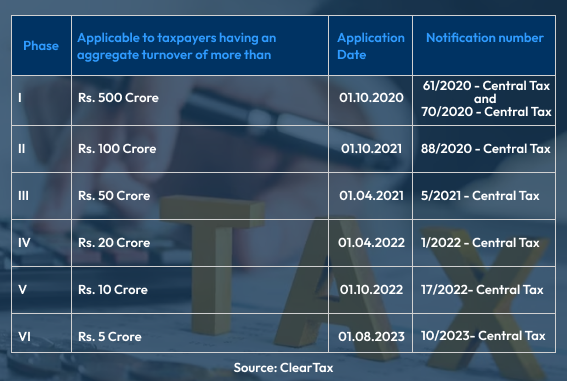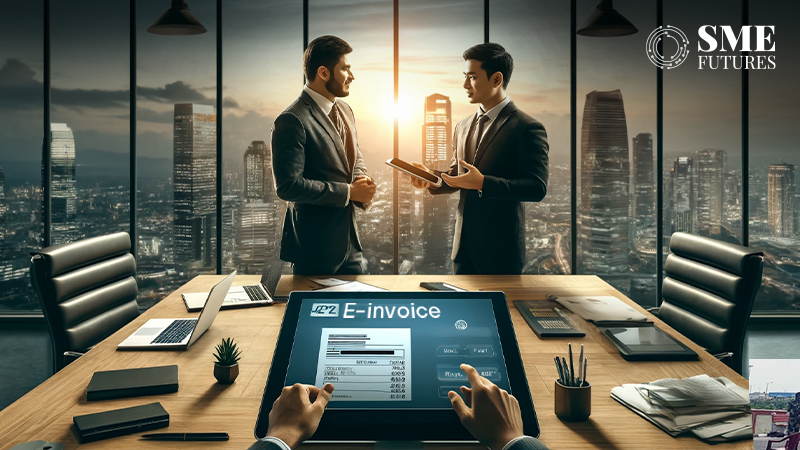Understanding e-invoicing
Electronic invoicing or e-invoicing is a system of electronic authentication of B2B invoices and related documents by using a Goods and Services Tax Identification Number on the GST portal. The implementation of this system was decided by the GST Council during its 35th meeting. Earlier, it covered mostly large enterprises but later expanded to medium and small enterprises.
E-invoicing is not about invoice-generation but about submitting already generated standard invoices on the common GST portal. The Invoice Registration Portal (IRP) managed by the GST Network (GSTN) issues an identification number against each invoice. The first IRP was launched by the National Informatics Centre (NIC) at einvoice1.gst.gov.in.
All the information gets transferred in real-time from IRP to the GST and e-way bill portals, thus avoiding manual data entry work.
Latest e-invoicing rules
As directed by the Central Board of Indirect Taxes and Customs (CBIC), B2B e-invoicing is mandatory for supplies to Special Economic Zones (SEZs) and registered persons (B2B), exports, and notified taxpayers. For Government entities, B2B e-invoicing rules are applicable in certain cases. On July 17, 2023, the GST Policy Wing released a clarification (GST Circular 198/10/2023) on B2B e-invoicing for the supplies provided to government agencies or departments. While complying with these guidelines, efficiency and transparency are maintained in all government-related transactions.
According to the clarification, government agencies, establishments, departments, Public Sector Undertakings (PSUs) and local authorities, which are tax deductors at source under section 51 of the CGST/SGST Act, must register themselves as per section 24(vi) of the CGST Act. Under GST law in clause (94) of section 2 of the CGST Act, such entities are regarded as registered persons. When the aggregate turnover of these registered persons exceeds the prescribed limit for e-invoicing, then it becomes mandatory for registered suppliers to issue e-invoices on transactions according to rule 48(4) of CGST Rules. Notified taxpayers who are supplying goods and services to government agencies or departments are obligated to generate B2B e-invoices including GSTIN of the respective government agency or department.
GST Circular 198/10/2023 outlines the crucial aspect of GST compliance in the country. A registered person with the same PAN number might have multiple GSTINs. Under the same PAN, multiple GSTINs contain all taxable, export and exempt turnovers. When it comes to calculating the aggregate turnover, it is not done as per individual GSTIN, instead, it is done based on PAN (Permanent Account Number).
According to Notification no. 13/2020 issued on 21st March, 2020, the persons on which e-invoicing is not applicable are insurers, financial institutions, banking companies, goods transport agencies that supply services for transportation of goods by road using a goods carriage, passenger transport, and SEZ (Special Economic Zone) units set up for manufacturing goods or rendering of services.
Since August 01, 2023, for e-invoicing to be applicable for any registered person, the threshold set for the registered person is more than 5 crores of aggregate turnover in the preceding financial years.
Understanding the developments
- On January 30, 2023, updates on NIC’s e-invoice portal said that ’96-Other Country’ POS state code can be selected by the user, where HSN (Harmonized System of Nomenclature) are 9965 and 9968. The second update was that only the documents dated October 01, 2021, and afterwards would be considered on the portal. Also, the portal added new error code 2295 apart from 2150.
- On April 13, 2023, GST Network advisories said that taxpayers with turnovers equal to or exceeding 100 crores must necessarily report credit-debit notes and tax invoices to IRP within 7 days of the invoice date from May 01, 2023.
- On May 06, 2023, the GST department announced the time limit of 7 days to report old e-invoices on IRP portals, by three months.
- On May 10, 2023, the Central Board of Indirect Taxes and Customs notified the 6th phase of electronic invoicing. According to this, those taxpayers shall issue e-invoices, whose aggregate turnover is above 5 crore rupees in any financial year from 2017-2018, effective from August 2023.
- On June 09, 2023, the e-Invoice QR Code Verifier app was launched by GSTN on Google Play Store. This will help users to do convenient and quick e-invoice verification.
- On June 12, 2023, NIC made it compulsory for all taxpayers whose turnover exceeded 100 crore rupees to login with two-factor authentication from July 15, 2023. This was necessary for both e-invoicing and e-way billings.
The following diagram shows the turnover criteria for GST e-invoicing:

Advantages of e-invoicing
- E-invoicing helps in resolving gaps in reconciliation of data under GST
- E-invoices on one software can be read by another software, enabling compatibility and saving on manual data-entry work
- Real-time tracking of invoices is possible
- Provides enhanced customer experience and helps small businesses to grow and do business with larger businesses
- Genuine input tax credits are available fast
What is mandatory?
The mandatory fields in an e-invoice include basic details, supplier information, recipient information, invoice item details, and document total. Details of the document total and items are the two mandatory annexures.
In all, this system is designed to promote digitalization, standardization, and interoperability in business transactions. The government keeps on taking steps to make financial processes easier, convenient and transparent for businesses and e-invoicing is one such step that is supporting large, medium and small businesses.











